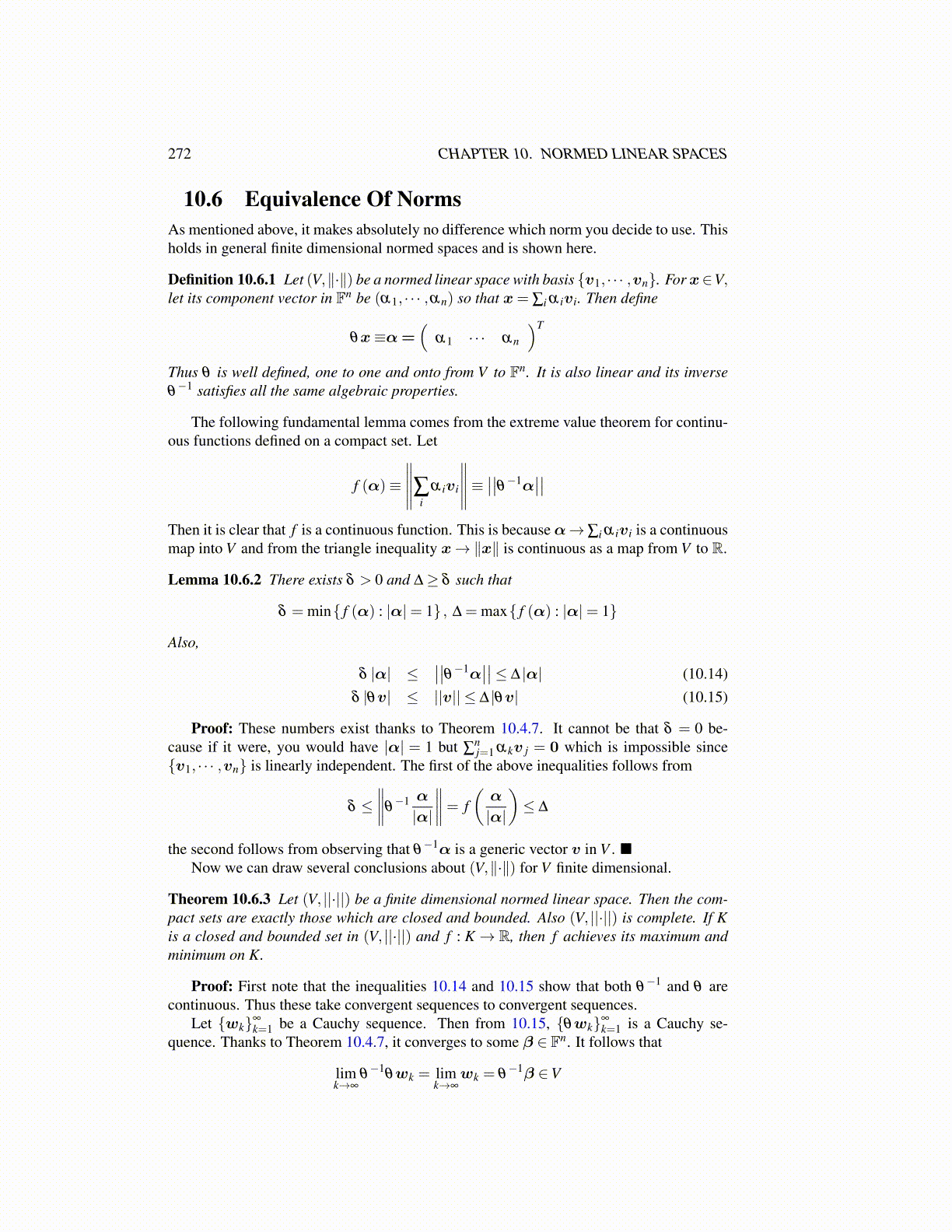
272 CHAPTER 10. NORMED LINEAR SPACES
10.6 Equivalence Of NormsAs mentioned above, it makes absolutely no difference which norm you decide to use. Thisholds in general finite dimensional normed spaces and is shown here.
Definition 10.6.1 Let (V,∥·∥) be a normed linear space with basis {v1, · · · ,vn}. For x∈V,let its component vector in Fn be (α1, · · · ,αn) so that x= ∑i α ivi. Then define
θx≡α=(
α1 · · · αn
)T
Thus θ is well defined, one to one and onto from V to Fn. It is also linear and its inverseθ−1 satisfies all the same algebraic properties.
The following fundamental lemma comes from the extreme value theorem for continu-ous functions defined on a compact set. Let
f (α)≡
∥∥∥∥∥∑iα ivi
∥∥∥∥∥≡ ∣∣∣∣θ−1α∣∣∣∣
Then it is clear that f is a continuous function. This is because α→∑i α ivi is a continuousmap into V and from the triangle inequality x→∥x∥ is continuous as a map from V to R.
Lemma 10.6.2 There exists δ > 0 and ∆≥ δ such that
δ = min{ f (α) : |α|= 1} , ∆ = max{ f (α) : |α|= 1}
Also,
δ |α| ≤∣∣∣∣θ−1α
∣∣∣∣≤ ∆ |α| (10.14)δ |θv| ≤ ||v|| ≤ ∆ |θv| (10.15)
Proof: These numbers exist thanks to Theorem 10.4.7. It cannot be that δ = 0 be-cause if it were, you would have |α| = 1 but ∑
nj=1 αkv j = 0 which is impossible since
{v1, · · · ,vn} is linearly independent. The first of the above inequalities follows from
δ ≤∥∥∥∥θ−1 α
|α|
∥∥∥∥= f(
α
|α|
)≤ ∆
the second follows from observing that θ−1α is a generic vector v in V . ■
Now we can draw several conclusions about (V,∥·∥) for V finite dimensional.
Theorem 10.6.3 Let (V, ||·||) be a finite dimensional normed linear space. Then the com-pact sets are exactly those which are closed and bounded. Also (V, ||·||) is complete. If Kis a closed and bounded set in (V, ||·||) and f : K → R, then f achieves its maximum andminimum on K.
Proof: First note that the inequalities 10.14 and 10.15 show that both θ−1 and θ are
continuous. Thus these take convergent sequences to convergent sequences.Let {wk}∞
k=1 be a Cauchy sequence. Then from 10.15, {θwk}∞
k=1 is a Cauchy se-quence. Thanks to Theorem 10.4.7, it converges to some β ∈ Fn. It follows that
limk→∞
θ−1
θwk = limk→∞
wk = θ−1β ∈V